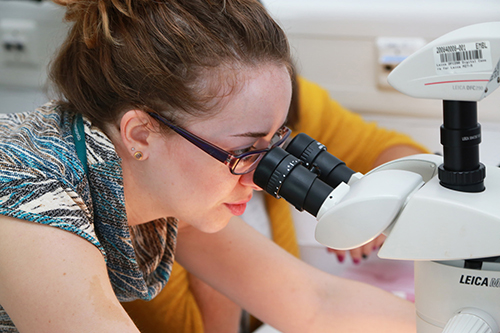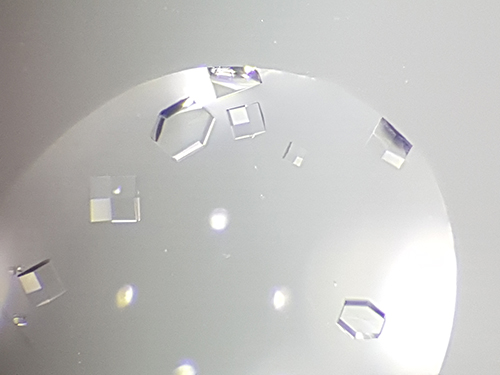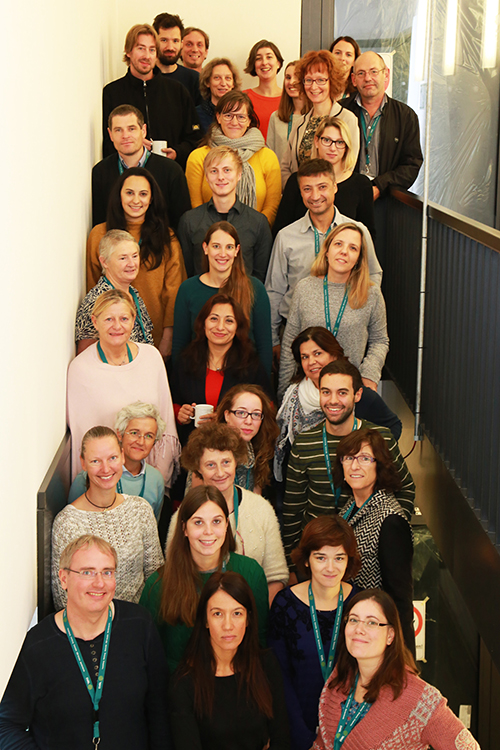Bringing structures to life Inspire article
Teachers from across Europe discover the beauty of protein crystallography.

under the microscope
Image courtesy of EMBL /
Rosemary Wilson
“Protein crystallisation is black magic” – these words are heard frequently in structural biology laboratories. In October 2016, 23 secondary-school teachers and teacher trainers explored how to bring the science behind this magic into European classrooms. Travelling from nine different countries, the participants arrived at the German Electron Synchrotron (DESY) campus in Hamburg eager to begin a two-day training workshop, or LearningLAB, organised by the European Learning Laboratory for the Life Sciences (ELLS) in collaboration with the European Molecular Biology Laboratory (EMBL).
The LearningLAB, called ‘Bringing structures to life – new ways of teaching biology’, provided an interactive introduction to the field of structural biology. Bridging the gap between research and schools, the workshop gave teachers the opportunity to work side-by-side with top scientists in an intense programme of hands-on activities, lab experiments, scientific seminars, and visits to the research and education facilities on the DESY campus.
The workshop began with an introduction to the theory behind protein crystallography. The discipline enables scientists to visualise the arrangement of atoms within proteins to understand their function. This in turn helps to understand processes in biological systems and makes it easier to design novel drug targets. To analyse a protein, scientists take advantage of the fact that proteins can be prompted to form crystals. In a crystal, millions of copies of the same protein are packed in a repeating three-dimensional array. When a synchrotron fires high-intensity X-rays at the crystal, the proteins diffract the beams into a pattern that can then be used to deduce the three-dimensional structure of the protein.
Under the guidance of EMBL scientists, the participants experienced first-hand the trickiest aspect of X-ray crystallography: growing a good protein crystal. To produce a crystal containing a well-ordered array of proteins, the teachers set up a screen to test varying crystallisation conditions – a process crystallographers use to find the perfect experimental conditions for a protein they have never crystallised before. “There are so many factors that play a role in getting a good crystal”, explained Philipp Hornburg, an EMBL PhD student who helped the workshop participants. This is also why protein crystallography is often referred to as ‘black magic’ – whether or not a protein crystallises is often unpredictable.

Image courtesy of Liliana Rodrigues
Unlike crystallographers, who might have to wait in suspense for days, weeks or even months to see whether their crystals grow, the LearningLAB participants only had to hold their breath until the next morning. Using stereo microscopes, 46 excited eyes searched for protein crystals and confirmed that the experiment was indeed a success: beautiful crystals could be observed and optimal crystallisation conditions for the protein determined. The teachers were eager to recreate the activity in their own classrooms, excited to enthuse their students with the art of crystallography and the power of scientific enquiry, just as they had been themselves.
After being introduced to the art of protein crystallography – both theoretically and practically – the teachers explored the EMBL labs and the experimental hall of the X-ray beamlines. Talks from EMBL group leaders Thomas Schneider and Rob Meijers gave participants an interesting insight into current research and hot topics in protein crystallography. The researchers shared their personal stories on what inspired them to become scientists and illustrated what important roles their teachers and mentors played along their career path.

trainers
Image courtesy of EMBL /
Rosemary Wilson
A career-themed session gave the participants the opportunity to quiz EMBL scientists about their motivations for becoming researchers, what they enjoy most about their job and how they deal with the challenges of a research environment. Is working with a method like protein crystallisation a frustrating experience? For Vivian Pogenberg, an EMBL research scientist, it is exactly this characteristic that makes his work particularly exciting: “I really enjoy the artistic aspect of my job. Because it is not an exact science, it allows me to play around with experimental protocols.”
Besides focusing on research and experimental aspects of X-ray crystallography, the course also fostered exchange and discussion about teaching structural biology in the classroom. A core part of the programme was dedicated to the presentation and discussion of ready-to-use teaching resources on structural biology and the study of proteins, presented by ELLS, Science in School, and three course participants. To add a further interdisciplinary component, the programme was complemented with a visit to the education facility physik.begreifen, an out-of-school physics lab on the DESY campus.
Portuguese teacher Tânia, from the Escola Secundária Filipa de Vilhena, summed up her experience: “The ELLS LearningLAB for teachers was a unique opportunity to discover and update my scientific knowledge in different biology fields, as well as to develop a new perception about modern science and cutting-edge technologies. I also had access to various innovative educational resources. Now I am able to give students a perspective of how scientific knowledge is really developed, highlighting the scientists’ work at EMBL, and hopefully to raise students’ interest in STEM careers. Every science teacher should try to attend these excellent courses!”





